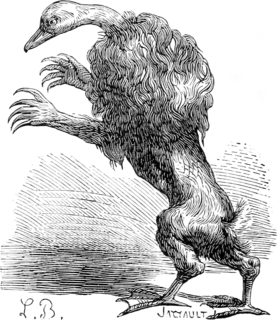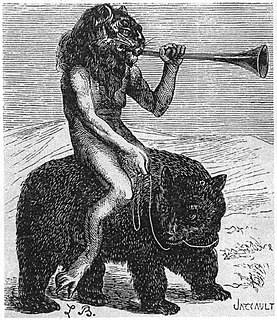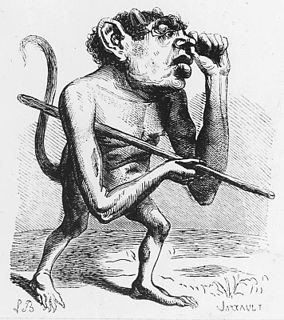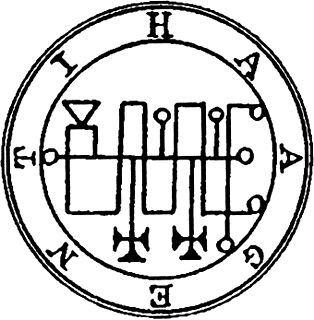In demonology, Vapula (or Naphula) is a powerful Great Duchess of Hell that commands thirty-six legions of demons. She teaches philosophy, mechanics, and sciences. [1] Vapula is depicted as a griffin-winged lion.

In demonology, Barbatos is an earl and duke of Hell, ruling thirty legions of demons and with four kings as his companions to command his legions. He can speak to animals, tell the future, conciliate friends and rulers, and lead men to treasure hidden by the enchantment of magicians.
The Lesser Key of Solomon, also known as Salomonis Regis or Lemegeton, is an anonymous grimoire on demonology. It was compiled in the mid-17th century, mostly from materials a couple of centuries older. It is divided into five books—the Ars Goetia, Ars Theurgia-Goetia, Ars Paulina, Ars Almadel, and Ars Notoria.
In demonology, Valefar is a Duke of Hell. He tempts people to steal and is in charge of a good relationship among thieves. Valefar is considered a good familiar by his associates "till they are caught in the trap". He commands ten legions of demons.

In demonology, Ipos is an Earl and powerful Prince of Hell who has thirty-six legions of demons under his command. He knows and can reveal all things, past, present and future. He can make men witty and valiant.
In demonology, Balam is a great and powerful king of Hell who commands over forty legions of demons. He gives perfect answers on things past, present, and to come, and can also make men invisible and witty.
Vassago is a demon described in demonological grimoires such as the Lesser Key of Solomon and the Book of the Office of Spirits.

Buer is a spirit that appears in the 16th-century grimoire Pseudomonarchia Daemonum and its derivatives, where he is described as a Great President of Hell, having fifty legions of demons under his command. He appears when the Sun is in Sagittarius. Like Chiron, the chief centaur of Greek mythology, he teaches natural and moral philosophy, logic, and the virtues of all herbs and plants, and is also capable of healing all infirmities and bestows good familiars.
In demonology, Gusion is a strong Great Duke of Hell, and rules over forty legions of demons. He tells all past, present and future things, shows the meaning of all questions that are asked to him, reconciles friends, and gives honor and dignity.

In demonology, Purson is a Great King of Hell, being served and obeyed by twenty-two legions of demons. He knows of hidden things, can find treasures, and tells past, present, and future. Taking a human or aerial body he answers truly of all secret and divine things of Earth and the creation of the world. He also brings good familiars.

The demon Naberius was first mentioned by Johann Weyer in 1583. He is supposedly the most valiant Marquess of Hell, and has nineteen legions of demons under his command. He makes men cunning in all arts, but especially in rhetoric, speaking with a hoarse voice. He also restores lost dignities and honors, although to Johann Weyer, he procures the loss of them.

In demonology, Glasya-Labolas is a mighty President of Hell who commands thirty-six legions of demons. He teaches all arts and sciences, in an instant, tells all things past and to come, and is the author and captain of manslaughter and bloodshed. He causes the love of both friends and foes, if desired, and can make a man invisible.

In demonology, Ronove is a Marquis and Great Earl of Hell, commanding twenty legions of demons. He teaches art, rhetoric, languages, and gives good and loyal servants and the favour of friends and foes.
In demonology, Phenex is a Great Marquis of Hell and has twenty legions of demons under his command. He teaches all wonderful sciences, is an excellent poet, and is very obedient to the conjuror. Phenex hopes to return to Heaven after 1,200 years, but he is deceived in this hope.
In demonology, Vepar is a strong Great Duke of Hell, and rules twenty-nine legions of demons. He governs the waters and guides armoured ships laden with ammunition and weapons; he can also make, if requested, the sea rough and stormy, and to appear full of ships. Vepar can make men die in three days by putrefying sores and wounds, causing worms to breed in them, but if requested by the conjurer he can heal them immediately.

In demonology, Vual is a mighty Great Duke of Hell, commanding thirty-seven legions of demons. He gives the love of women, causes friendship between friends and foes, and tells things past, present and to come.

In demonology, Haagenti is a Great President of Hell, ruling thirty-three legions of demons. He makes men wise by instructing them in every subject, transmutes all metals into gold, and changes wine into water and water into wine.

Valac is a demon described in the goetic grimoires The Lesser Key of Solomon, Johann Weyer's Pseudomonarchia Daemonum, the Liber Officiorum Spirituum, and in the Munich Manual of Demonic Magic as an angelically winged boy riding a two-headed dragon, attributed with the power of finding treasures.
In demonology, Corson is one of the four principal kings that have power over the seventy-two demons that are supposedly constrained by King Solomon, according to the Lesser Key of Solomon). Corson is not to be conjured except on great occasions.
In demonology, Murmur is a Great Duke and Earl of Hell, and has thirty legions of demons under his command. He teaches Philosophy, and can oblige the souls of the deceased to appear before the conjurer to answer every desired question. Before his rebellion against God, Murmur held the name "Matthias."
In demonology, Crocell is the 49th spirit of the Goetia, manifesting as an angel with a tendency to speak in dark and mysterious ways. Once a member of the Powers, he is now a Duke of Hell who rules over 48 legions of demons. When summoned by a conjuror, he can teach geometry and other liberal sciences. He can also warm bodies of water, create the illusion of the sound of rushing waters, and reveal the location of natural baths. He is associated with water.
| | This occult-related article is a stub. You can help Wikipedia by expanding it. |